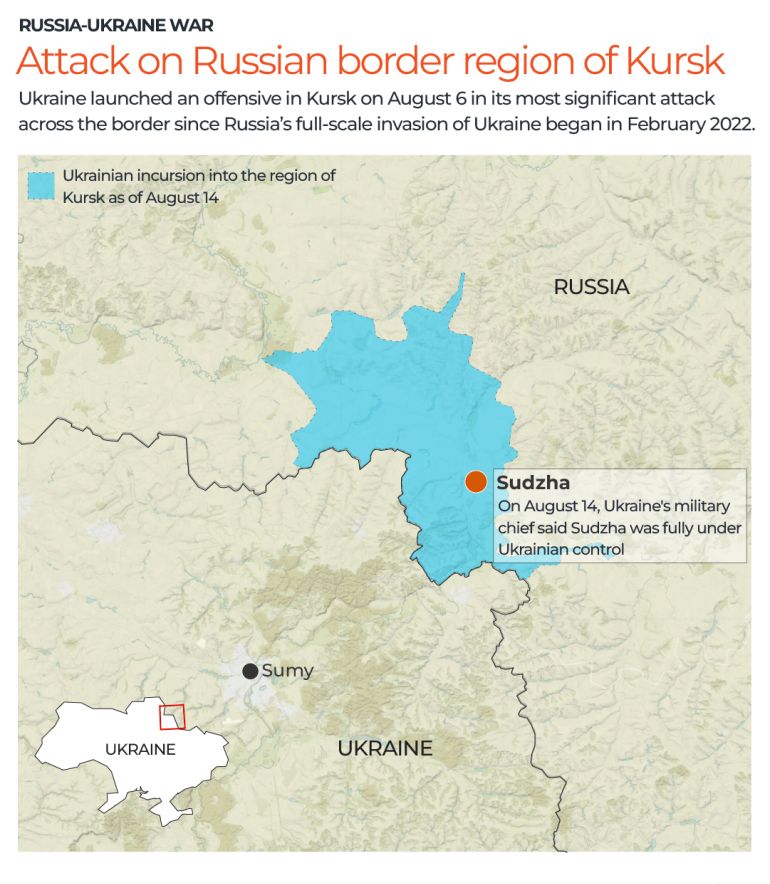
(Map from Al Jazeera, Institute for the Study of war)
Overview
Ukraine launched an audacious counter-offensive into Russia’s Kursk Oblast region on 6 August, opening a new front. Named “Operation Krepost” (Slavic), it has sparked intense military debate. Ukraine’s decision to extend the front line into a remote region of Russia is debatable, particularly at a time when the Ukrainian front in the Donbas is under severe pressure. It is unlikely to force a recoil of Russian forces as it is neither a counterstroke nor a counterattack, instead a counter-offensive opening up another front. While “Operation Krepost” has created an operational surprise and limited success it has so far failed to achieve any decisive leverage to stymie the Donbas front adversity.
Ukraine had to pull out units from active engagements in the Donbas into a heterogenous force of 8000-10000 troops, creating vulnerabilities on the primary Donbas front. The Russian response was to deploy forces specifically tasked with defending the border regions of Belgorod, Kursk, and Bryansk, without creating operational vulnerability in the Donbas. The strategic value of Kursk is questionable, and the strain it places on Ukraine’s military may outweigh any perceived potential gains.
Strategic Intent: Strategic Dislocation or Strategic Outstretch
The Kursk offensive marks a pivotal moment in the war, reflecting a shift in strategy following the Ukrainian setbacks of 2023. This operation, aimed at reclaiming Russian territory, showcases Ukraine’s adaptability and determination. Ukraine’s counterstroke and counterattacks in 2023 failed to achieve the desired end state, proving they didn’t have the numbers and resources, against a well-fortified Russian deployment.
Thus a counter-offensive possibly intended to take the pressure off the Russian Donbas offensive, improving Ukraine’s negotiating position, exposing Russia’s strategic weaknesses, and changing the narrative. Yet its strategic outstretch is debatable given the limited war stamina and resources. The tactical and operational success may not thus achieve the desired strategic end state.
Some of the possible Kiev’s strategic intents thus could be as under.
- Political Messaging: Ukraine’s Kursk operation is as much a political statement as a military manoeuvre. President Zelenskyy’s political messaging is to demonstrate Ukraine’s strength, revitalise and justify international support but also to challenge the narrative of a Russian invincibility. The capture of Russian territory has both psychological and territorial payoffs.
- Counter-Offensive and Strategic Dislocation: As a counter-offensive (different sector distant), not a counter-stroke (same sector in proximity) the operation could divert Russian resources from the critical front and stymie the execution momentum in Donbas. However it would also disproportionately stretch Ukrainian forces which are already stretched and lacking resources. On the other hand Russia, with its superior force generation, can draw resources from its northern army group without weakening the Donbas front.
- Improve Conflict Termination Profile: Ukraine can improve its conflict termination profile and subsequently create leverage during post-conflict negotiations. However, the strategic value of Kursk is insignificant compared to the Donbas, yet both the threat to nuclear assets and the psychological impact of a loss of face are far-reaching for Russia. The challenge would remain post-conflict administration and defending the area which could also have a hybrid complexion.
- Create Strategic Nuclear Assets Dilemma: The Kursk Nuclear Power Plant is located just 60 kilometres from the Ukrainian border. If seized despite it being heavily protected, it could lead to a radiological disaster and potentially catastrophic for Ukraine at the international level. Russia could also react with its strategic assets as it would imply the red line being crossed.
- Strategic Embarrassment and Psychological Advantage: While the counter-offensive may not change the overall strategic balance of the war or significantly disrupt the Russian offensive, it has certainly caused strategic embarrassment to Russia and could be a catalyst for both sides seeking peace.
- Shift in the War Narrative: Information warfare warriors from the West jumped the narrative space to announce the catastrophic failure of preparedness by the Russian Ministry of Defence and loss of face. The realist strategist termed it as a wasteful drama which could become the villain of Donbas defensive effort. Yet it could temporarily transform public sentiment and re-energising Ukraine’s international supporters.
Operational Strategy and Force Application Matrix
The Ukrainian operational strategy was “Choke, Extend, and Hit.” The ‘Choke’ comes by destroying lines of communication like bridges, supply depots and critical war assets. The ‘Extension’ comes from over-extending and exhausting Russian army war stamina already under stress. The ‘Strike’ aims to capture territory with fewer troops and equipment by offensive launching from interior lines of operation and exploiting the exterior of Russia in Kursk.
Operationally the force sequencing and application matrix aimed to ensure a high mounting and execution tempo. The force posturing and orchestration were accordingly set into place. The key operational dynamics of force, space and time were well executed to achieve ascendancy. The force application matrix was innovative with UAV assaults first to target the Russian airfields/UAV assets and thereafter key military dispositions/assets. The artillery and HIMAR assaults followed pulverising the area to be occupied by the airborne forces. Following this sequencing, the mechanised brigade moved mop over the area of remanent resistance and occupied territory. Simultaneously the lines of communication with Russia cut off by targeting key bridges and other choke points. This maintained a high execution tempo at the least cost and minimum time.
Lessons of Operational Art in Kursk 2.0
To unravel the mystique of operational art; it is important to comprehend the four essential operational concepts of Commanders Intent, Centre of Gravity (COG), Lines of Operations and Culmination Point. The aspect of the Commander’s intent has been already covered. The others and some more are covered here.
C of G and Operational Focus: While Ukraine may link the Kursk offensive to strategically dislocate Donbas operations, the leverage, time and tempo were not in favour of the desired end state. For Russia, the Kursk offensive posed a significant dilemma of whether to prioritise their operations in the Donbas or respond more forcefully to Ukraine’s incursion. Focus on the offensive in Donbas while holding the Kursk with a defensive posture was preferred and sensible. Kursk may thus be a temporary setback till restoration operations are launched.
Lines of Operation: Both Ukraine and Russia have extended the lines of operation and face the daunting task of managing two major ground campaigns. Further, the Ukrainians in Kursk operated from the interior lines of attack while the Russians in the sector had vulnerabilities defending on the exterior lines. Further, the Ukrainians correctly identified the decisive points enroute with a proper understanding of ‘Intelligence Preparation of Battlespace’ to destroy bridges, dominate choke points, render air and UAV bases ineffective and operational interdiction.
Culmination Point: The principle of war of operational reach and culmination point was not in Ukraine’s favour with its current war stamina. While the Kursk has been innovatively planned, with deep operations and interdictions, the strain on resources and personnel will constrain the operational execution tempo and also impact operational balance in the Donbas sector. The loss of critical equipment and personnel in the Kursk offensive could hinder Ukraine’s ability to launch future large-scale operations. The outcome of the operation will heavily influence Ukraine’s position in any potential negotiations, with success depending on the attrition they can inflict on Russian forces.
Operational Surprise: In all the hype of transparent battlespace, surprise and deception seemed old-fashioned and legacy concepts. Then 7 Oct 2023 Hamas happened and now Kursk 2.0. have highlighted its power and relevance. This is not to mention the Indian experience of Kargil or Galwan.
Ukraine’s ability to maintain operational secrecy before the assault reflects innovative military planning. Ukrainian forces have achieved tactical surprise in Kursk, exploiting weaknesses in the Russian defensive structure. However, the operation’s success is limited by Ukraine’s shortage of troops and equipment, forcing Kyiv to commit its reserves. The strain on Ukraine’s resources could lead to overextension, leaving them vulnerable if Russian forces regroup and counterattack.
Audacity and Seizing the Initiative: Ukraine’s bold manoeuvre into Kursk exemplifies audacity and operational dislocation. Its importance was established by the action of the Indian Army in Chushul Sector 2020 to occupy key operational heights for an operational advantage. But history teaches us about the potential outcomes of such a high-risk strategy that sustaining the offensive and maintenance of momentum must be planned not only for the conflict termination profile but also for the management of captured areas. The advantage must not be lost.
Distance Punishment Versus Adaptive Manoeuvre: The war in Ukraine has shown that manoeuvre and firepower are complementary combat dynamics. Precision engagement (by distance punishment) like UAVs and HIMAR brings only one of the five elements of combat power (manoeuvre, firepower, leadership, protection and information) to the battlefield. The need is to move from precision engagement to adaptive engagement and from deep manoeuvre to decisive manoeuvre. In the Kursk offensive, the preparation of battlespace by precision engagement followed by decisive manoeuvre showcased the intrinsic relationship between attrition and manoeuvre.
Conclusion
The Kursk counter-offensive is a strategic gamble, and time will tell whether it was an operational master stroke. While the operational objectives are debatable, its strategic prospects seem bleak. The Donbas remain the centre of gravity of the conflict, and any diversion of resources for a counter-offensive in low-priority sectors like Kursk can create additional vulnerabilities for Ukraine. The offensive surprised Russia with a temporary setback, reinvigorating Ukrainian morale and altering the international perspective on the conflict. However, this high-stakes strategy carries significant risks. Operation Krepost is operationally innovative and audacious but strategically ill-sighted creating vulnerabilities.
References
Veronika Melkozerova, “As Kyiv makes gains in Kursk, Russia strikes back in Donetsk”,eu, 15 Aug 2024, https://www.politico.eu/article/ukraine-russia-offensive-prisoners-of-war-invasion-kursk-zelenskyy-putin/
Howard Altman, “Kursk Invasion Plan Developed By Lessons Learned From Failed Counteroffensive: Retired Ukrainian Officer, Yahoo News, 14 Aug 2024, https://www.yahoo.com/news/kursk-invasion-plan-developed-lessons-160512266.html
Hanna Duggal, “Mapping Ukraine’s surprise incursion into Russia’s Kursk
Region”, Al Jazeera, 15 Aug 2024, https://www.aljazeera.com/news/2024/8/15/mapping-ukraines-surprise-incursion-into-russias-kursk-region
Jack Watling, “Ukraine’s extraordinary incursion into Kursk has changed the narrative of the war– but is a high-risk strategy”, 17 Aug 2024, https://www.google.com/search?client=safari&rls=en&q=Ukraine%E2%80%99s+extraordinary+incursion+into+Kursk+has+changed+the+narrative+of+the+war%0A%E2%80%93+but+is+a+high-risk+strategy&ie=UTF-8&oe=UTF-8
Mick Ryan, “The Kursk Offensive Dilemma, Futura Doctrina,19 Aug 2024, https://mickryan.substack.com/p/the-kursk-offensive-dilemma













